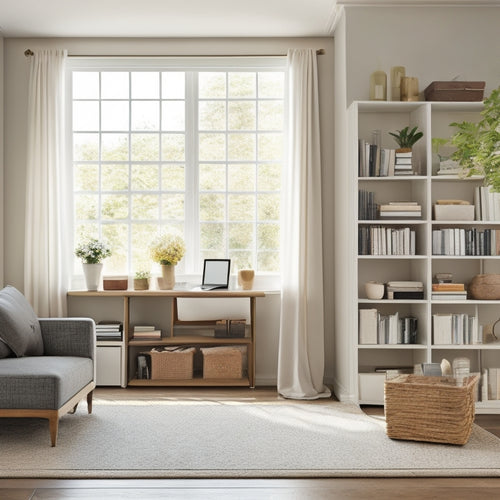
10 Best Ways to Organize Kitchen Utensils Efficiently
Share
You're looking to optimize your kitchen's efficiency by organizing your utensils. Start by utilizing vertical storage solutions like shelves, hooks, and pegboards to free up counter and cabinet space. Designate zones for utensils based on functionality and placement near cooking stations to reduce clutter and save time. Invest in utensil holders that fit your utensils, available space, and material durability. Maximize your drawer organization with dividers, categorization, and hanging solutions. Implement a pegboard system and countertop optimization strategies to take your kitchen to the next level. There's more to explore to create your dream kitchen - let's get started!
Key Takeaways
• Implement vertical storage solutions like shelves, hooks, and pegboards to maximize space and keep frequently used utensils accessible.
• Designate zones for utensils based on functionality and placement near cooking stations to reduce clutter and save time.
• Select utensil holders that fit available space, utensil types, and are durable, placing them strategically near sink, stove, and refrigerator.
• Organize utensils in drawers by categorizing them by function, size, and color, and use dividers and hanging solutions to prevent clutter.
• Utilize a pegboard system to allocate a dedicated area for frequently used utensils, customizing it based on utensils and available wall space.
Utilize Vertical Storage Spaces
By installing shelves, hooks, or a pegboard on your kitchen walls or the back of a door, you can maximize your kitchen's vertical storage spaces and keep frequently used utensils within easy reach. This is a great way to free up counter and cabinet space, making your kitchen feel more organized and efficient.
Consider using wall-mounted racks to store items like pots, pans, and utensils. Under cabinet hooks can also be used to hang items like mugs, tea towels, or even a cookbook.
Another option is to utilize hanging baskets or magnetic strips to store smaller items like spices, oils, or cleaning supplies. These can be easily installed on the side of a cabinet or fridge, keeping them out of the way but still easily accessible.
Designate Zones for Utensils
You can further optimize your kitchen's organization by assigning specific zones for your utensils, ensuring that each item has a designated home and making it easier to find what you need when you need it. By doing so, you'll avoid clutter and reduce the time spent searching for a specific tool.
To create these zones, consider the following strategies:
-
Use drawer dividers to separate utensils within a drawer, keeping similar items together.
-
Place utensil caddies near cooking stations, such as a crock near the stove or a utensil holder near the prep counter.
-
Install wall hooks for hanging items like pots, pans, or utensils with holes, freeing up cabinet space.
- Apply magnetic strips to the side of a cabinet or fridge to store metal utensils, keeping them within easy reach.
Invest in Utensil Holders
Investing in utensil holders designed specifically for your kitchen's unique needs can greatly enhance the organization and functionality of your designated zones. By doing so, you'll be able to optimize your utensil organization and create a more efficient cooking environment.
When selecting utensil holders, consider the types of utensils you use most frequently and the available space in your kitchen. For instance, if you have a lot of countertops, look for wall-mounted or hanging utensil holders to free up surface area.
When designing your kitchen, think about the 'work triangles' between your sink, stove, and refrigerator. Place utensil holders near these areas to create a seamless workflow. You can also use dividers or inserts to separate utensils within a holder, making it easier to find what you need quickly.
Additionally, consider the material and durability of the holder, as well as its ease of cleaning. By investing in the right utensil holders, you'll be able to maintain a clutter-free kitchen and focus on what matters most – cooking and enjoying delicious meals.
Maximize Drawer Organization
To maximize drawer organization, categorize your kitchen utensils into groups, such as baking, cooking, and serving, and assign a specific drawer or section to each group. This will help you maintain a sense of order and make it easier to find what you need when you need it.
To take your drawer organization to the next level, consider the following strategies:
-
Organize utensils by size, with the largest items in the back and the smallest in the front, making it easier to access what you need.
-
Use color coding to separate utensils into categories, such as red for baking utensils and blue for cooking utensils.
-
Invest in drawer divider options, such as inserts or tray dividers, to keep utensils separated and prevent clutter from building up.
- Consider hanging solutions, like adhesive hooks or a hanging organizer, to store utensils like spatulas or whisks on the back of a cabinet door or wall.
Implement a Pegboard System
By allocating a specific area for frequently used utensils and tools, a pegboard system can help maintain the organization and categorization established in your drawers. This system offers several advantages, including easy access to essential items, reduced clutter, and increased productivity.
To customize your pegboard, consider the types of utensils you use most frequently and the available wall space in your kitchen. You can choose from various pegboard sizes and styles, or even create your own using a wooden board and hooks.
When installing your pegboard, keep in mind space-saving tips, such as placing it near a workstation or above a countertop. This will allow you to quickly grab what you need while keeping the countertops clear. You can also add bins, baskets, or trays to store small items like spices, oils, or condiments.
Optimize Countertop Real Estate
With your pegboard system in place, now turn your attention to maximizing the use of your countertops by designating zones for specific tasks, such as food preparation, cooking, and storage. This will help you maintain a clutter-free kitchen and optimize your workflow.
To achieve this, you'll want to allocate specific areas for frequently used items. For instance, consider installing hanging hooks near your cooking zone to store pots, pans, and utensils within easy reach.
Here are some additional strategies to optimize your countertop real estate:
-
Use compact caddies to store spices, oils, or condiments near your cooking zone, keeping them easily accessible.
-
Designate a specific area for food preparation, such as a large cutting board or a countertop-mounted herb planter.
-
Reserve a section of your countertop for storage, like a utensil organizer or a basket for storing snacks.
- Consider investing in a countertop cart or island with built-in storage to expand your kitchen's functionality.
Choose Multi-Functional Tools
When selecting multi-functional tools for your kitchen, you'll want to ponder space-saving design options that maximize storage capacity.
By opting for tools that serve multiple purposes, you'll be able to consolidate your utensil collection, freeing up valuable space and reducing clutter.
Space-Saving Design Options
You can maximize your kitchen's real estate by investing in multi-functional tools that combine two or more tasks in one device, freeing up valuable space for other essentials. This approach is especially effective when it comes to utensil storage, as it allows you to declutter your utensil drawer and kitchen cabinet.
Here are some space-saving design options to contemplate:
-
A garlic press with a built-in grater
-
A spatula with a built-in bottle opener
-
A measuring cup with a built-in scale
- A kitchen shears with a built-in nutcracker
Tool Consolidation Benefits
By consolidating multiple functions into a single tool, you'll reap the benefits of a streamlined kitchen workflow, reduced clutter, and increased productivity. This approach to tool organization is a game-changer for home cooks and professional chefs alike.
With multi-functional tools, you'll have fewer items to store, making it easier to maintain a tidy kitchen. This, in turn, will help you stay focused on the task at hand, rather than wasting time searching for the right utensil.
When you choose tools that can perform multiple tasks, you'll experience efficiency benefits that will transform the way you cook. For example, a silicone spatula with a built-in bottle opener or a chef's knife with a built-in sharpening steel can simplify your kitchen tasks.
Label and Categorize Utensils
Categorizing your kitchen tools into groups like baking, cooking, and serving utensils helps establish a logical structure for your labeling system. This step is essential in maintaining your kitchen organized and maximizing your storage space. By grouping similar items together, you can easily identify what you have and where it's located.
To elevate your labeling system, consider the following organizing hacks:
-
Use color coding to distinguish between categories, like red for baking tools and blue for cooking tools
-
Designate a specific spot for each tool to uphold order and simplify cleaning
-
Personalize your storage solutions by utilizing dividers or bins that suit your specific requirements
- Implement a 'first in, first out' system to make sure that older items are used before they expire
Store Heavy Items Below
Three-quarters of your kitchen's heavy items, such as stand mixers and slow cookers, should be stored in lower cabinets or on bottom shelves to maintain stability and accessibility. This will prevent them from falling and make it easier for you to lift them when needed.
You can also install hanging hooks on the walls or on the back of a door to hang heavy pots, pans, or utensils, freeing up cabinet space. When storing heavy items in drawers, use drawer dividers to separate them and keep them organized. This will prevent scratching and make it easier to find what you need.
Additionally, consider storing heavy items near the area where you'll be using them, such as storing your stand mixer near the counter where you'll be baking. By storing your heavy items below, you'll create a more efficient and organized kitchen that makes cooking and baking a breeze.
Establish a Maintenance Routine
Now that you've organized your kitchen utensils, maintaining your space is crucial to prevent clutter from building up again.
You'll want to establish a routine that includes daily habits, weekly deep cleaning, and a monthly utensil audit to keep your kitchen running smoothly.
Daily Habit Formation
Set aside a specific time each day to maintain your organized kitchen utensils, such as right after dinner or during your morning routine, to guarantee that your space stays clutter-free and functional.
By doing so, you'll ensure that your kitchen layout remains optimized for efficiency, and you'll reap the organizational benefits of a well-maintained space.
To make daily habit formation a breeze, try the following strategies:
-
Track your progress: Keep a habit tracker or a planner to monitor your daily maintenance routine. This will help you stay accountable and motivated.
-
Designate a 'home' for each utensil: Assign a specific spot for each kitchen tool, making it easier to put things back in their place.
-
Clean as you go: Wipe down countertops, and wash dishes immediately after meals to prevent clutter buildup.
- Make it a habit loop: Pair your daily maintenance routine with an existing habit, like brushing your teeth or taking a morning coffee, to create a consistent routine.
Weekly Deep Cleaning
Every week, dedicate one hour to deep cleaning your kitchen utensils and tools to maintain a pristine and functional space. This regular maintenance routine will help prevent clutter from building up and keep your kitchen organized.
Set aside a specific day and time each week, and stick to it. During this hour, focus on quick cleaning tasks such as wiping down countertops, cleaning utensil holders, and sanitizing high-touch areas.
In addition to your weekly deep clean, remember to schedule monthly decluttering sessions to get rid of unnecessary items and seasonal reorganization to adjust your storage and layout according to the changing needs of your kitchen.
By committing to these regular cleaning and organization tasks, you'll be able to maintain a sense of order and efficiency in your kitchen. Remember, regular maintenance is key to keeping your kitchen utensils and tools organized and within reach.
Monthly Utensil Audit
Your monthly utensil audit serves as a critical checkpoint in your maintenance routine, making sure that your kitchen remains clutter-free and functional by identifying redundant or broken items that need to be replaced or discarded.
This process is essential for effective inventory management and helps you stay on top of your utensil maintenance.
During the audit, take the time to:
- Review your utensil rotation schedule to guarantee that items are being used regularly and not left idle for extended periods.
- Inspect each utensil for signs of wear and tear, and set aside those that need repair or replacement.
- Implement decluttering tips by removing any duplicates or unnecessary items that are taking up valuable space.
- Update your inventory list to reflect any changes or additions, making sure that you have a clear picture of what you have and what you need.
Frequently Asked Questions
How Do I Prevent Utensil Holders From Collecting Dust and Dirt?
To prevent utensil holders from collecting dust and dirt, you'll want to regularly clean your utensil drawer and hanging hooks with a damp cloth, then dry them thoroughly to prevent moisture buildup.
Can I Use Adhesive Hooks on My Kitchen's Tile Backsplash?
'A bird in the hand is worth two in the bush,' so start by considering adhesive hooks on your tile backsplash for convenient utensil storage; however, make sure the hooks are suitable for your tile type and won't damage it.
What Is the Ideal Depth for a Utensil Drawer Organizer?
When planning your utensil drawer organizer, you'll want to contemplate a depth of around 2-3 inches for easy access to your frequently used items, maximizing kitchen efficiency and space-saving solutions for the best drawer organization and utensil storage.
Are There Any Utensil Organizers Suitable for Renters or Small Kitchens?
You're a master chef maneuvering a tiny kitchen, and utensil organization is your treasure map. For renters or small kitchens, you'll find perfect fit solutions in wall-mounted racks, drawer dividers, hanging baskets, and magnetic strips that maximize space without renovations.
How Often Should I Clean and Sanitize My Utensil Organizers?
You should clean and sanitize your utensil organizers every 1-2 weeks to maintain hygiene, depending on usage, and consider implementing storage solutions with built-in sanitizing features to make hygiene maintenance and organization hacks a breeze.
Related Posts
-

10 Essential Skills for Mastering Home Organization
You're ready to take control of your space and transform it into a haven of calm and productivity. Mastering home org...
-

Transform Your Space: 5 Online Courses to Help
Ready to transform your space from cluttered to calm? Start with mastering home organization fundamentals, like declu...
-

What's the Best Home Organization System for ADHD?
You need a home organization system that acknowledges your unique brain chemistry and works with your ADHD, not again...


